The next-gen MacBook Pro with Retina Display Review
by Anand Lal Shimpi on June 23, 2012 4:14 AM EST- Posted in
- Mac
- Apple
- MacBook Pro
- Laptops
- Notebooks
Last year when I wrote about the new MacBook Airs I offered two forward looking paragraphs:
What happens from here on out is what's really interesting. Intel has already committed to moving the TDP of its mainstream parts from 35W - 45W down to 10 - 20W. Since the Air is the new mainstream Mac notebook, Apple has already made that move. The performance in this 10 - 20W segment is going to get much better over the next two years, particularly once Haswell arrives.
The Thunderbolt Display is the first sign of what's to come. Moving IO controllers and expansion into the display, and potentially even moving discrete GPUs out of the notebook are all in store for us. Apple is really ahead of the curve here, but it's easy to imagine a future where laptops become a lot more like the new Air and shift to a couple high bandwidth ports instead of numerous lower bandwidth connections.
Perhaps I was being too aggressive in the prediction of a couple of high bandwidth ports. After all, the next-generation MacBook Pro with Retina Display features four such IO ports (2 x Thunderbolt and 2 x USB 3.0). But you get my point. Gigabit Ethernet and Firewire 800 are both gone. The discrete GPU is still present but I suspect even its days are numbered, at least inside the chassis. The personal computer as we knew it for so long, is changing.
The personal computer is getting thinner, lighter, more integrated and more appliance-like. The movement is no longer confined to just Apple either. The traditional PC OEMs are following suit. Even Microsoft has finally entered the PC hardware business, something it threatened to do for years but hadn't until now. Distribution models will change, the lines between different form factors will continue to blur. What was once a mature industry is going through a significant transformation. It’s exciting but at the same time it makes me uneasy. When I first got into this industry everyone had stories of companies with great ideas that just didn’t make it. As we go through this revolution in computing I’m beginning to see, first hand, the very same.
Apple makes the bulk of its revenue from devices that don’t look like traditional personal computers. For the past couple of years I’ve been worried that it would wake up and decide the traditional Mac is a burden, and it should instead be in the business of strictly selling consumer devices. With its announcements two weeks ago in San Francisco, I can happily say that my fears haven’t come true. At least not yet.
It’s been a while since Apple did a really exciting MacBook Pro launch. Much to my surprise, even the move to Sandy Bridge, the first quad-core in a MacBook Pro, was done without even whispers of a press conference. Apple threw up the new products on its online store, shipped inventory to its retail outlets, updated the website and called it a day. Every iPhone and iPad announcement however was accompanied with much fanfare. The MacBook Pro seemed almost forgotten.
With its WWDC unveil however Apple took something that it had resigned to unexciting, dare I say uncool status, and made a huge deal about it. Two weeks ago Apple did the expected and offered relatively modest upgrades to all of its portable Macs, all while introducing something bold.
Apple calls it the MacBook Pro with Retina Display. You’ll see me refer to it as the next-gen MacBook Pro, Retina MacBook Pro, rMBP or some other permutation of these words.
After using it for the past two weeks I can honestly say it’s the best Mac Apple has ever built. And there’s a lot more to it than hardware.
Portability
If you were hoping for a 15-inch MacBook Air, that’s not what the rMBP is. Instead it is a far more portable 15-inch MacBook Pro. I have to admit I was a bit let down the first time I laid eyes on the next-gen MacBook Pro, it looks good but it doesn’t look all that different. The disappointment quickly faded as I actually picked up the machine and started carrying it around. It’s not ultra light, but man does it make the previous chassis feel dated.
While I never really liked lugging around the old MBP (and it always made me feel like the old fogey at tradeshows where everyone else had something 13-inches or smaller), carrying the rMBP is a pleasure by comparison. Pictures really don’t do it justice. The impressively thin display assembly or overall chassis thickness look neat in a photo but it’s not until you actually live with the rMBP that you can appreciate what Apple has done here. I carry around a 15-inch MacBook Pro because it’s my desktop, and as such it’s incredibly useful to have with me when I travel. For my personal usage model, the Retina MacBook Pro is perfect.
If your workload demands that you need the performance of a MacBook Pro and your lifestyle requires you to carry it around a lot, the reduction in thickness and weight alone will be worth the upgrade to the rMBP. If you spend most of your time stationary however, you’ll have to be sold on the display and internal characteristics alone. The bad news is if the design doesn’t get you, everything else will.

From left to right: 11-inch MacBook Air, 13-inch MacBook Air, 15-inch MacBook Pro, MacBook Pro with Retina Display
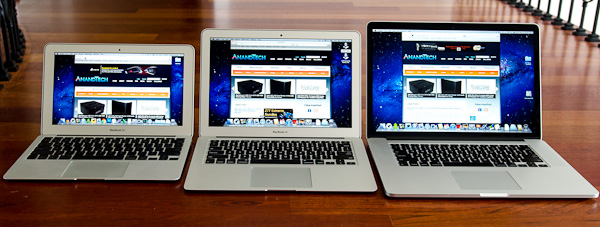
From left to right: 11-inch MacBook Air, 13-inch MacBook Air, MacBook Pro with Retina Display
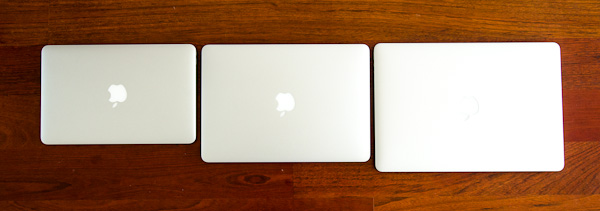
From left to right: 11-inch MacBook Air, 13-inch MacBook Air, MacBook Pro with Retina Display


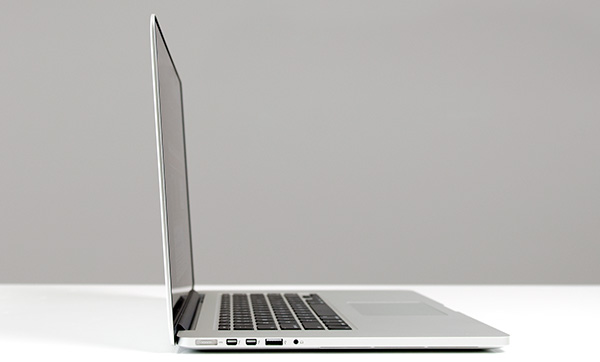
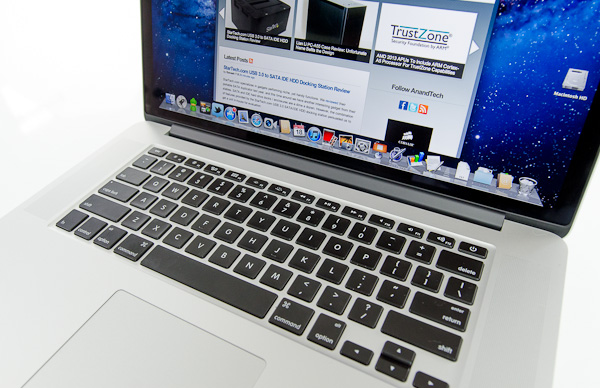
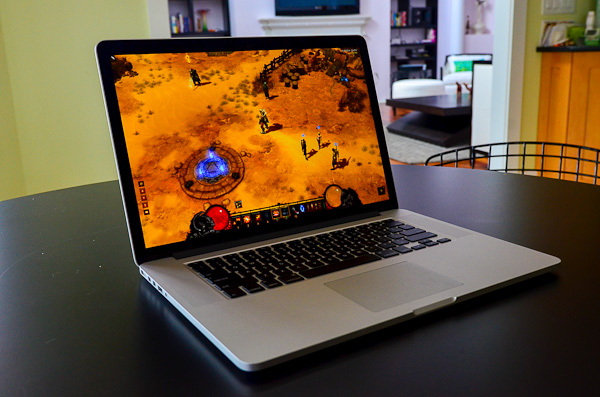
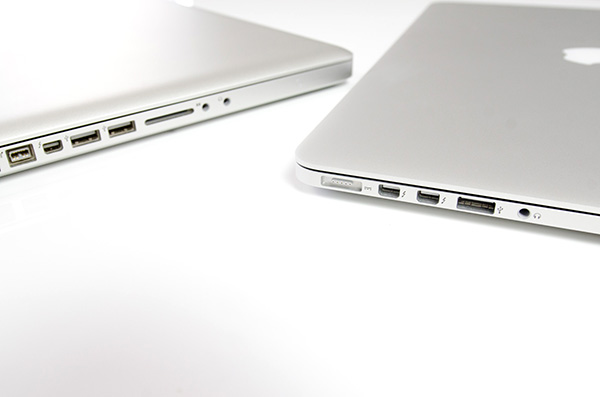
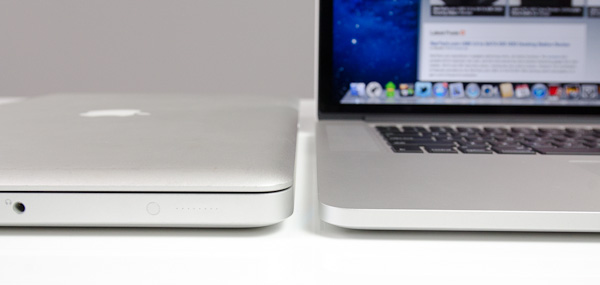








471 Comments
View All Comments
EnzoFX - Saturday, June 23, 2012 - link
Just let apple push down the high end tech, let it trickle, and let pc manufacturers bring up their game, is it not a win win? Haters gonna hate, so lost.MacTheSpoon - Saturday, June 23, 2012 - link
I have to say, after having tried one out in an Apple Store, that I was pretty surprised how underwhelming and minor the screen improvement was. I would have thought from all the breathless press coverage that it was going to be a life-changer like apparently it was for Anand, but the fact was that looking at the thing at waist-height on its bench I personally couldn't even tell the difference. I had to stick my nose in it to see a difference. From a normal typing distance I could see a bit more of a difference, but not as much as I'd imagined.Maybe it's just that I have crappy eyes, but I didn't see a single other customer in the store looking at the displayed laptops, either. I bet most walked by without even noticing the different display--because laptops are already pretty close to a retina display at normal usage distances. It's not like a phone, where you hold the thing up to your face.
I also found it disappointing that 1080p stuff looked so small. You had to blow it up to full screen, and then it seemed...well, it didn't seem that sharp. It was pretty underwhelming. My test material was the Big Buck Bunny vid on YouTube. I thought, so I would pay all this money and end up with this subpar viewing experience?
Honestly I think I would probably prefer a great 1080p display with a full sRGB gamut. I like the black levels and contrast on the MBP, but you can pretty much get that and more on other laptops. And matte, too.
The thing that I liked most about the machine, when all was said and done, was its looks. I love the thinness. And the lack of the wedge shape, which never appealed to me. But I left the store feeling like I wasn't missing out on anything too amazing by not having that screen. For a pro machine I'd probably want a workstation with full gamut and as much storage as possible. For a multimedia machine I'd probably wait to see how the XPS 15 redesign turned out. It will probably offer better speakers, storage, and color for less than half the price.
Ohhmaagawd - Saturday, June 23, 2012 - link
I had exact opposite reaction. I went to the Apple store yesterday and was blown away by the screen.But you can't use youtube for your testing, they are all fuzzy.
Spoony - Saturday, June 23, 2012 - link
Sublime review, as we always relish from Anandtech.To follow up, what do we know about the thermal performance of Kepler and IVB in the 2011-style MBP chassis?
Additionally, does opting for the 2.3GHz model do any significant favors for temperature or battery life?
Reading this review on a Retina iPad was amusing because all the pictures were fuzzy. The web has a way to go before it looks great at 220+ dpi.
da1bigkahuna - Saturday, June 23, 2012 - link
I was wondering if you had any fairly broad comparisons you could make that we might expect from Haswell - and it's successor. I mean something like, "Haswell should be at least 10% faster overall, but the next chip will increase speed far more". Any info would be appreciated, but ultimately speed is the main thing. Next main thing would be if thunderbolt will be a lot better in those future systems.dagamer34 - Saturday, June 23, 2012 - link
I believe Haswell is another tock in terms of GPU design, and all CPUs are designed for far lower thermal limits. Anand has referred to it as the "ideal" ultrabook CPU, allowing for it to even be in the screen of a computer with a minor increase in thickness.houkouonchi - Saturday, June 23, 2012 - link
The reason I bought my first Mac. Of course I run at the native 2880x1800 (I ditch the HiDPI).The big problem I have had so far is getting it working in linux. Seems like really bad linux support right now. The nvidia driver doesn't want to work and the thunderbolt ethernet also doesn't work. The wireless is also really shoddy which made it a pain in the but to just get my linux installation moved over (probably easier if I installed off a USB cd-rom drive).
I am coming from a 22.2 inch 3840x2400 (204PPI monitor) so going to a 220 PPI laptop at native resolution was no big stretch for me. On linux I run X at 75 DPI even on those dense monitors. Its all about the desktop real-estate for me.
houkouonchi - Saturday, June 23, 2012 - link
Just to add its funny that running at the native 2880x1800 is the only way to have third-party apps look good (like word processors/excel/pdf that you can up the font/text size on). Also using safari + google maps the plugin was rendered at 1/4th the resolution. Rendered correctly when running native 2880x1800.krazyfrog - Saturday, June 23, 2012 - link
I would like you guys to add a webcam test as it will help judge the quality of the built-in webcam and microphones. Otherwise, a fantastic review, as usual.LuckyKnight - Saturday, June 23, 2012 - link
I hope Apple release a 13" Macbook Pro with dedicated graphics and a slightly better screen!!